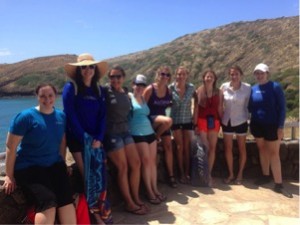With the (repeat) exception of Bubbie’s Ice Cream, Hanauma Bay is the first location to which we’ve returned on our adventures in Oahu. The nature preserve is closed every Tuesday to allow time for maintenance or research, a management practice we greatly appreciated last week when we assisted a team from NOAA with a green turtle health assessment. This trip to the bay presented an entirely different conservation lesson on the tourist pressure on coral reefs. At 8:30 a.m. we pulled into an already overflowing parking lot. As we walked down the hill to the ticket booth, we ogled at the expansive line of visitors holding brightly colored inter-tubes and glopping large, white blobs of sunscreen on their skin.
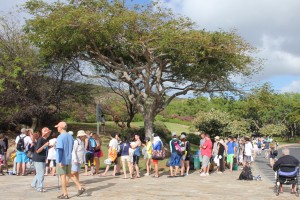
Elizabeth Maynard, the Education Leader of the UH Sea Grant Hanauma Bay Education Program, led us to the nature preserve’s education center and informed us of the bay’s long history. The first instances of use began with the Hawaiian nobility including King Kamehameha and Queen Ka‘ahumanu, who fished and entertained visitors, but it was officially put on the tourist map with the 1961 film Blue Hawaii starring Elvis Presley. The land was given to the City and County of Honolulu by the Bishop Estate in 1927 and subsequently opened for public use, and in 1967 the state declared the waters the first Marine Life Conservation District, prohibiting all take of marine resources. But a rapid rise in tourism and growing popularity of the bay led to an unsustainable level of visitation, reaching 3.6 million a year or 10,000 people per day by 1987.
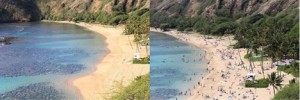
Stories about the destruction of the preserve’s resources led the Department of Parks and Recreation to adopt an eight-point management plan, which included hiring a manager and developing the education program. Elizabeth showed us pictures of the first efforts to inform the visitors about the bay; volunteers stood behind a card table with makeshift signs in multiple languages explaining the impacts of hundreds of thousands of people on the reef. Today, the city has developed a 9-minute educational video that all visitors must watch if they want to enter Hanauma Bay. In a debrief later in the day, we discussed the ability of the Little Mermaid-esque music telling the crowds to “Don’t step on me, at Hanauma, here in the sea. When you tread on the fauna or coral ‘ohana you’re stepping on me.” to influence the myriad of demographics that travel through each year. Elizabeth explained that this is a particularly daunting challenge when you consider many peoples motivations for visiting. Hanauma Bay is often included in larger tour packages or added to an imaginary list of activities visitors “must-do” when they come to Hawai’i, which has led some to ask her where to find the jet skis or why there has to be so many fish in water.
After the education center, we hurried down the hill with our snorkel gear in tow towards the water. While the beach was still crowded, it was clear that the management plan, including restrictions on tour companies, traffic control, and an entry fee, was able to radically reduce the total number of visitors to a manageable 800,000 per year from the late 1980s highs.
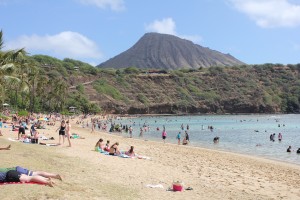
I quickly took off into the water with Amy, my snorkel buddy, with the goal of reaching the outer reef. Over 95% of visitors stay within the shallow waters of the inner reef, a fact that was troublingly obvious as we swam over numerous broken and algae covered stony coral. Despite the degraded reef, there were thriving populations of a variety of reef fish.
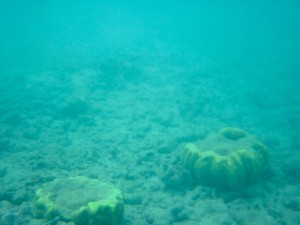
We found an opening and passed into the outer reef, and after only a few meters the health of the coral rapidly increased. We saw massive, healthy coral head after coral head and schools of butterflyfish, tang, surgeonfish, parrotfish, and trumpetfish, to name a few. We even bobbed along with a green sea turtle, or honu, relaxing in the surf!

As we swam back to shore, the impact of the hundreds of thousands of tourists on the reef was even more discernible. Just as I started to feel disheartened about our abilities to protect this magnificent resource, a young Australian tourist popped her head above the water and took out her snorkel to remind me, a stranger, to not step onto the reef below! With those words it was clear that education and management can reach the thousands of people who visit Hanauma Bay every year and potentially help to preserve not only this place but other ocean resources in Hawai’i and beyond.
